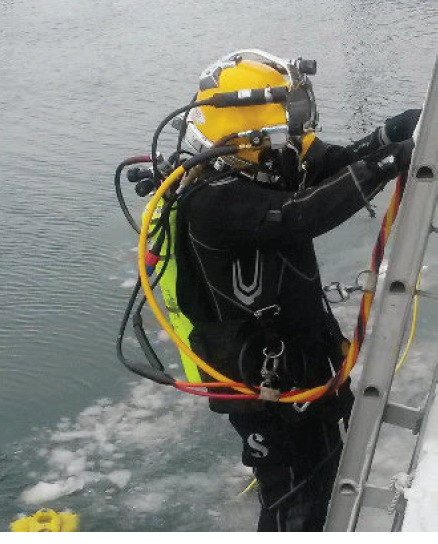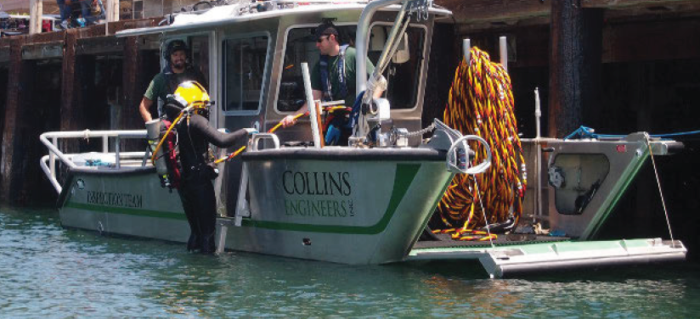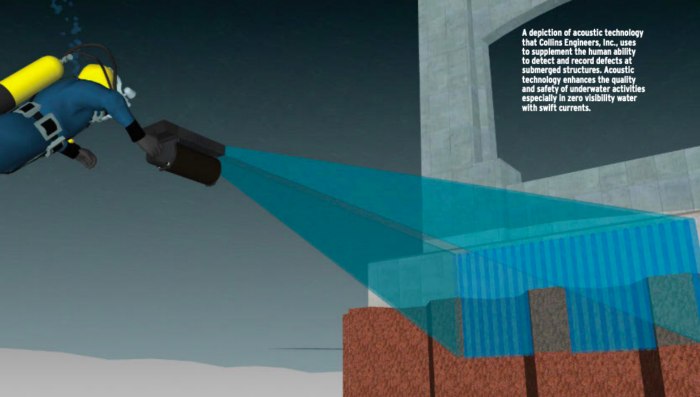AMERICAN COUNCIL OF ENGINEERING COMPANIES (ACEC)
The challenges of underwater engineering are remarkable, but technology is driving innovation.
 Engineering has always revolved around the idea of expanding and extending the reach of humans. However, in the ongoing quest to build better transportation systems, more elaborate energy infrastructure and advanced telecommunications networks, it is easy to overlook a basic fact: Many projects involve underwater elements—and the scope of these projects is often complex and challenging.
Engineering has always revolved around the idea of expanding and extending the reach of humans. However, in the ongoing quest to build better transportation systems, more elaborate energy infrastructure and advanced telecommunications networks, it is easy to overlook a basic fact: Many projects involve underwater elements—and the scope of these projects is often complex and challenging.
“There is a great deal of innovation that goes into constructing, maintaining and repairing underwater structures and systems,” says Terry Browne, vice president of safety at Collins Engineers, Inc., a full-service civil engineering firm that specializes in underwater projects.
Underwater engineering is not for the faint of heart—or the short of breath. Dropping transoceanic cable at several thousand meters or sending divers to inspect bridges or deep-water oil platforms in near-zero underwater visibility is not only rife with difficulties, it can delve into the realm of dangerous and expensive. These projects require advanced know-how, sophisticated technology and a willingness to push the boundaries of conventional thinking— and engineering. Venturing beneath the surface of a river, lake, reservoir or ocean is far different than the engineering and construction that takes place on terra firma.
“Unseen situations equate to unknown conditions of critical infrastructure, along with unknown hazards,” says Browne.
How do firms specializing in underwater engineering accomplish seemingly impossible tasks? How do they put innovative concepts and leading-edge technologies to work?
Using an array of tools and expertise—from sophisticated dive suits and submersibles to sonar, acoustical imaging, LiDAR, electromagnetics and big data analysis—engineers navigate adverse pressures, poor visibility and strong currents in order to build and maintain the bridges, oil platforms, wind farms and pipelines that keep the world functioning.
“These projects involve complex and expensive infrastructure,” says Nicholas Welz, director of submarine cable systems for Tetra Tech, Inc., an engineering firm that specializes in major ocean and reservoir projects.
A Different World
Underwater engineering can encompass a diverse array of tasks, including:
- Design-stage data gathering
- Environmental permitting and archeological studies
- Subsurface construction monitoring and quality control
- Maritime threat assessments
- Rapid condition assessment following a seismic event, storm or accident
- Erosion detection and documentation
- Evaluating existing infrastructure
“Any work that is done above water may be accomplished below water with the proper planning, training, approach and understanding that there are additional obstacles that must be overcome,” says Shanon Chader, chief of the Coastal/Geotech Team and district dive coordinator for the U.S. Army Corps of Engineers (USACE) in Buffalo, New York.
Although the fundamentals of engineering remain the same on land or at sea, the way that underwater specialists approach projects can vary considerably. It is not unusual for teams to work in conditions where they cannot see components and equipment, where currents and pressure present extreme difficulties and dangers, and where forces and physics affect structures in entirely different ways.
Chader points out that limited visibility, water temperature, varying air temperature, wind, waves and other environmental factors can further ratchet up the challenges and risks. Teams may work in icy or polluted water and confront dangerous creatures.
“My dive team has had to deal with snakes, fire ants, dolphins, sharks and large alligators to name a few,” he says.
 Of course, building and maintaining bridges, tunnels, dams, pipelines, oil and wind platforms, cables and other infrastructure also require specific technical acumen—and the right equipment.
Of course, building and maintaining bridges, tunnels, dams, pipelines, oil and wind platforms, cables and other infrastructure also require specific technical acumen—and the right equipment.
“The technology and processes are often very different than projects taking place on the land,” says Michael J. Ganas, vice president and director of underwater and marine engineering projects at Boswell Engineering. The company performs underwater inspections and designs and manages or monitors underwater construction, inspections, maintenance and repairs of waterfront facilities such as dams, piers, bridges and other water-based structures. The firm has worked extensively with the New York State Department of Transportation, the Port Authority of New York and New Jersey and various other entities.
What makes the task more challenging is the fact that there is an “out of sight and out of mind” perception of these projects by marine facility owners, whereby information obtained by a servicing entity on the condition of a submerged structure must be accepted on good faith, though that information may essentially be erroneous. As such, underwater inspection is one of the most abused areas of civil engineering, according to Ganas. Underwater structures and equipment often deteriorate faster and more severely than comparable structures exposed to the atmosphere. This can lead to additional maintenance costs, damage, risks and dangers. Additionally, building these highly specialized structures and spotting defects is only part of the challenge.
“Personnel must not only be proficient in commercial diving techniques to gain access to submerged structural elements, they must also possess a firsthand knowledge of a wide array of deterioration processes and their causes,” Ganas says.
Working Under Pressure
At the heart of underwater engineering is a basic fact: Advances in materials, methods and technology have radically changed the way firms approach projects. According to Welz, processes take place faster, more efficiently and within a safer framework than a decade or two ago.
“In the 1980s and 1990s, engineers used paper charts taped together and a wax pencil to plan transoceanic cable systems,” Welz says. “The planning process could take weeks or months to complete. Now you have GIS systems that can generate a contour map of the bottom and can model the way you are going to install the cable. The system can tell you exactly how much slack you are going to need to reach over bottom contours—and ensure that you have exactly the right amount of cable going over the stern as you lay the cable.”
 These systems also depict underwater surfaces, including scour depressions, debris accumulation and exposed pier footings. As a result, engineers and other specialists, such as data scientists, must understand how to use sonar, LiDAR and other systems to develop reports and visualizations that aid in a project. The accuracy of data is crucial.
These systems also depict underwater surfaces, including scour depressions, debris accumulation and exposed pier footings. As a result, engineers and other specialists, such as data scientists, must understand how to use sonar, LiDAR and other systems to develop reports and visualizations that aid in a project. The accuracy of data is crucial.
“There is a tremendous amount of liability associated with underwater operations, and firms should adequately risk-assess operations, constantly improve staff capabilities and embrace technological innovations,” says Browne.
However, the technical, practical and logistical challenges do not stop there. Assembling all the equipment and systems required for a project can prove daunting. It is often necessary to transport specialized vessels—ranging from zodiacs to specially equipped boats—to a site. This may mean transporting a boat across land or sea, or locating a suitable vessel near a job site. Once at the location, there is often a need to hire a local captain who is familiar with the waters and how to navigate through them smoothly and safely. In addition, it is sometimes necessary to transport high-tech equipment and engineering systems by airplane or helicopter.
“This may involve security and customs clearances,” says Browne. “Further complicating matters, different industries and countries have different requirements and regulations.”
Finally, at an underwater job site, an engineering firm may require advanced communications systems for both voice and data. There is often a need to share a display of geospatially submerged data points or underwater images in real time with clients and contractors located in a different city, country or continent. Setting up these systems requires specific expertise.
“No two sites are the same,” says Browne.
Download full article (PDF): Beneath the Waves
Download full March/April 2019 issue of Engineering, Inc.
 About the American Council of Engineering Companies
About the American Council of Engineering Companies
www.acec.org
The American Council of Engineering Companies (ACEC) is the voice of America’s engineering industry. Council members – numbering more than 5,000 firms representing more than 500,000 employees throughout the country – are engaged in a wide range of engineering works that propel the nation’s economy, and enhance and safeguard America’s quality of life. These works allow Americans to drink clean water, enjoy a healthy life, take advantage of new technologies, and travel safely and efficiently. The Council’s mission is to contribute to America’s prosperity and welfare by advancing the business interests of member firms.
Tags: ACEC, American Council of Engineering Companies, Engineering Inc., Underwater, underwater engineering






 RSS Feed
RSS Feed